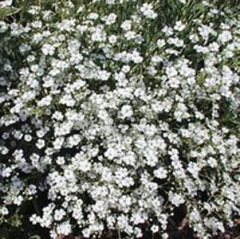Baby's breath
| Infobox on Baby's breath | |
|---|---|
| Example of Baby's breath |  |
| Facts | |
| Origin | - |
| Stowage factor (in m3/t) | - |
| Humidity / moisture | - |
| Ventilation | - |
| Risk factors | - |
Baby's breath
Contents
Description
Scientific name and introduction
Gypsophila paniculata. A favourite for use in bouquets and dried flower arrangements, gypsophila is most often field grown. The flowers are sensitive to water deficit and intense sunlight, and will brown and shrivel easily if subjected to these stress conditions. On the other hand, damp or rainy conditions increase the risk of gray mould (Botrytis) and Phytophthora root rot. Gypsophila is Greek for ‘gypsum-loving’ in reference to this species’ good growth performance in high calcium soils.
Quality characteristics and criteria
Gypsophila plants produce flowers on large panicles whose individual flowers open over a considerable time period. Flowering stems are usually cut 20 to 40 cm long. The degree of maturity at harvest is determined by whether the flowers are intended for the fresh market or for dried arrangements. Stems are cut when 50% of the flowers are open if they are to be placed in a drying solution immediately or marketed within 24 hrs. Stems are cut when 20% to 30% of the flowers are open if they are to be dried later or held longer than 24 hrs. Purchase gypsophila that has plenty of unopened buds, show no signs of water stress, wilting, or disease (brown florets).
Grading and bunching
Stems are gathered into field bunches using rubber bands or ties to secure the cut ends.
Ethylene sensitivity
Exposure to ethylene causes wilting of open flowers and sleepiness of opening buds.
Pretreatments Gypsophila responds best to pre-treatment with STS, which protects not only open florets but also the developing buds. Gypsophila flowers treated with STS and held in a solution containing Physan will maintain excellent display life for several weeks, as new buds open on the panicle. However, STS sometimes is of little benefit because stem blockage prevents uptake. Be sure stems are rinsed and re-cut underwater before placement in STS.
Storage conditions:
Store at 0° to 1°C in high (90%) RH to reduce flower and stem desiccation. Because Botrytis can be a serious problem, florists should ask suppliers (or be prepared themselves) to treat with appropriate fungicides. Stems with about 50% of their flowers open can be kept in a preservative solution (200 ppm Physan) at 1°C for up to 3 weeks.
Packing: Gypsophila may be packed in horizontal boxes or hampers. Thirty bunches are packed in a standard box.
Special considerations
Gypsophila harvested in the bud stage (5% of flowers open) can be opened to excellent quality in a bud-opening solution containing 200 ppm Physan-20 and 5% to 10% sucrose. Flowers should be held at about 20°C, 50% RH, and with light levels of about 15 mmol.m-2.sec-1 PAR (use cool-white fluoresecent lamps). For drying gypsophila, a solution containing 1 part glycerine to 2 parts water should be used. Cut stems are then dried by hanging bunches upside down in a warm dry environment.











